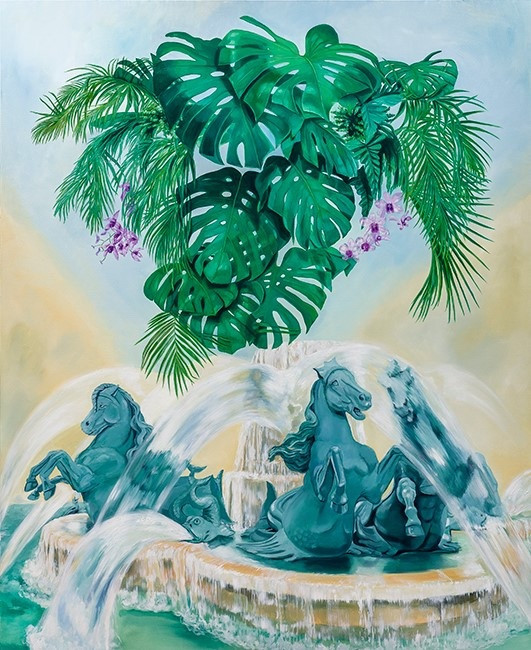 Monika Behrens, Whisperer I, 2020
Monika Behrens, Whisperer I, 2020Courtesy of the artist
Fountains adorn public spaces as amenities for civic gathering and speak to the way urban space is constructed and renewed. Despite their egalitarian function and appeal, public monuments are ideologically loaded sites governed by the sociopolitical and cultural imperatives of their time. Their grandeur often collides histories of conquest and colonisation with mythology and invention. How history rubs up against the individual within collective municipal contexts in the present makes public monuments important if not contested emblems of representation. In her two paintings of the Fontaine de l'Observatoire, located in the Jardin du Luxembourg of Paris, Monika Behrens meshes the fact of its historic context with flights of fancy and imagination through works expanding the conventions of still life painting.
In 2019, Behrens undertook a residency in Paris at the Cité Internationale des Arts following the completion of a practice-led doctorate examining the Dutch still life tradition of the 17th century at the University of New South Wales. A well-rehearsed aspect of art history, the apparent realism of Dutch still life painting abounds with rich symbolic evidence of memento mori – a reminder of death – as depicted through wilting flowers, rotting fruit or the fading light of the day. Situating her still life arrangements in relationship to the French capital’s magnificent fountains – icons of 19th century Haussmannisation – became a practical fixture of her everyday routine. Attending the residency with family in tow, Behrens would take her infant daughter to the nearby fountain as it helped the child get to sleep amid the unsettling racket of city life. Meditative and calming, the streaming water was a hypnotic form of white noise, a kind of ‘whisper’ that would inspire the paintings’ title.
The cloistered balance and symmetry Behrens had previously explored with still life conventions found in the fountains of Paris a much livelier and freer setting than the genre ordinarily permits. Replacing Jean-Baptiste Carpeaux’s quartet of classical human sculptures at the centre of the iconic fountain with hovering tropical foliage ruptures realism, creating a scene where still life and dreamscape coalesce. Memento mori’s reminder of death becomes instead a reminder to dream. Behrens’s palette, dominated by the matching greens of the water and foliage, is deliberately off-kilter and artificial. Heroic and noble, the horses sculpted by Emmanuel Frémiet are frozen mid-leap from a history made by white male urban planners into an oneiric adolescent cartoon. Behrens sketched the scene in Paris for paintings later made in Sydney; this process set the scene for memory to impart its wistful filter of unreliability. In Whisperer, the symbolic narratives at the heart of still life painting are gently subjectivised by Behrens into a story where the mother–daughter relationship animates the past through the conditions of the present.
 Monika Behrens, Whisperer II, 2020
Monika Behrens, Whisperer II, 2020Courtesy of the artist
Catalogue essay for The Art of Giving at Macquarie University Art Gallery, Sydney, December 2022 – March 2023.
Published by Macquarie University in 2022.